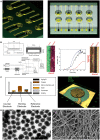Review of micro/nanotechnologies for microbial biosensors
- PMID: 26029689
- PMCID: PMC4426784
- DOI: 10.3389/fbioe.2015.00061
Review of micro/nanotechnologies for microbial biosensors
Abstract
A microbial biosensor is an analytical device with a biologically integrated transducer that generates a measurable signal indicating the analyte concentration. This method is ideally suited for the analysis of extracellular chemicals and the environment, and for metabolic sensory regulation. Although microbial biosensors show promise for application in various detection fields, some limitations still remain such as poor selectivity, low sensitivity, and impractical portability. To overcome such limitations, microbial biosensors have been integrated with many recently developed micro/nanotechnologies and applied to a wide range of detection purposes. This review article discusses micro/nanotechnologies that have been integrated with microbial biosensors and summarizes recent advances and the applications achieved through such novel integration. Future perspectives on the combination of micro/nanotechnologies and microbial biosensors will be discussed, and the necessary developments and improvements will be strategically deliberated.
Keywords: bioreactor; micro/nanomaterials; micro/nanotechnology; microbial biosensor; microfluidics; riboswitch; sensory-regulative biosensor.
Figures



References
-
- Arefev K. M., Guseva M. A., Khomchenkov B. M. (1987). Determination of the coefficient of diffusion of cadmium and magnesium vapors in gases by the Stefan method. High Temp. 25, 174–179.
-
- Ben-Yoav H., Ofek Almoga R., Sverdlova Y., Sternheimb M., Belkinc S., Freemand A., et al. (2012). Modified working electrodes for electrochemical whole-cell microchips. Electrochim. Acta 82, 109–11410.1016/j.electacta.2012.03.042 - DOI
Publication types
LinkOut - more resources
Full Text Sources
Other Literature Sources

